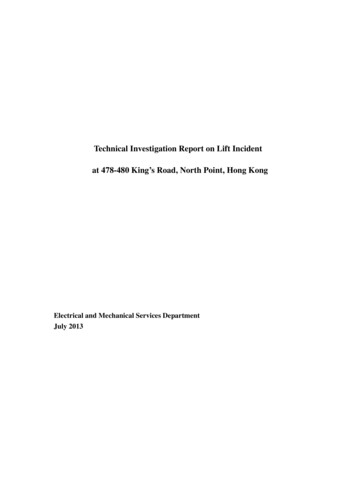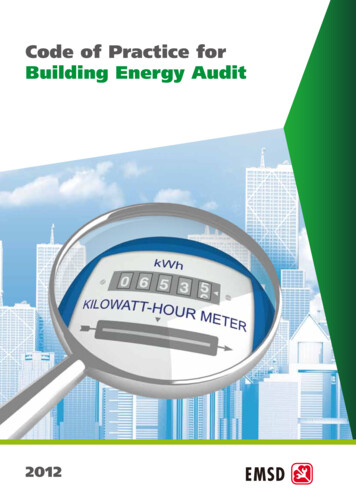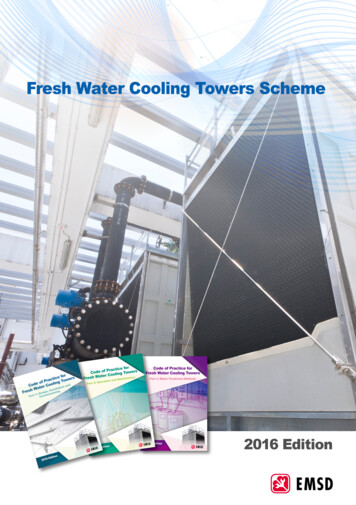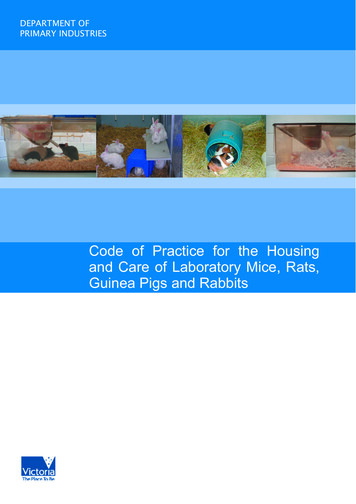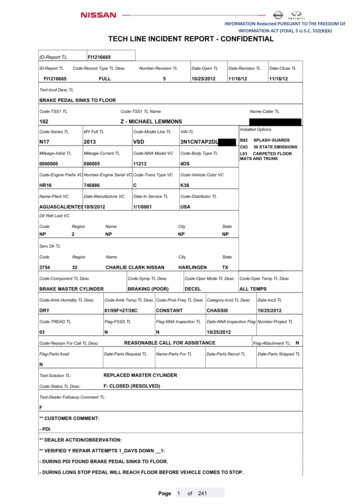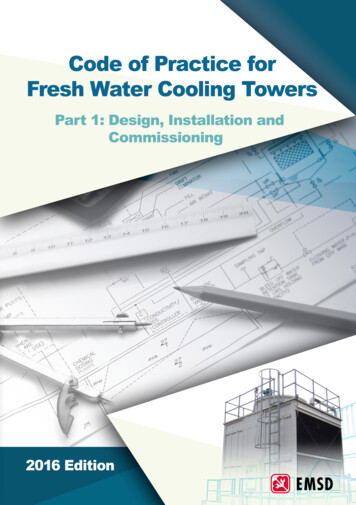
Transcription
Code of Practice for Fresh Water Cooling TowersPart 1: Design, Installation and CommissioningCODE OF PRACTICEFORFRESH WATER COOLING TOWERSPART 1: DESIGN, INSTALLATION ANDCOMMISSIONING2016 EDITION(DEC 2016)Electrical and Mechanical Services DepartmentThe Government of the Hong Kong Special Administrative Region2016 Editioni
Code of Practice for Fresh Water Cooling TowersPart 1: Design, Installation and CommissioningForewordThis Code of Practice was prepared to promote the proper use of fresh water coolingtowers with guidelines for cooling tower design, installation, testing, commissioning,operation and maintenance in order to meet the energy efficiency objective with dueconsideration of the environment and health issues. It was developed by the Task Forceon Code of Practice for Fresh Water Cooling Towers.Part 1 of this series of Code of Practice for Fresh Water Cooling Towers (previously knownas Code of Practice for Water-cooled Air Conditioning Systems) provides details on thedesign, installation and commissioning of cooling towers. It should be read in conjunctionand made cross-reference with the followings:Part 2 – Operation and Maintenance; andPart 3 – Water Treatment Methods.2016 Editionii
Code of Practice for Fresh Water Cooling TowersPart 1: Design, Installation and 12.Cooling Tower Types and Cooling Tower Systems2.1General2.2Cooling Tower Types2.3Cooling Tower System33393.Cooling Tower Construction and Installation Requirements3.1Cooling Tower Shell3.2Intake Louvre3.3Fill3.4Fan and Fan Motor3.5Water Basin3.6Drift Eliminator3.7Water Distribution Pipework3.8Water Circulation Pipework3.9Water Sampling Point3.10Deflector3.11Silencer3.12Plume Abatement Measures3.13Access Opening3.14Cooling Tower Structure3.15Ladder and Handrail3.16Installation Access3.17Cooling Tower Supporting ling Tower Installed Location162016 Editioniii
Code of Practice for Fresh Water Cooling TowersPart 1: Design, Installation and ling Towers installed on Building RoofCooling Towers installed on Podium RoofCooling Towers installed indoors with Vertical Dischargethrough Roof or Horizontal Discharge through Side WallCooling Towers installed at Other LocationsMinimum Separation between Cooling TowersMinimum Separation from Physical BarrierInstallation Location at a Composite Building (Residential andCommercial)Installed Location not fulfilling the Required MinimumSeparation1618181919191920205.Cooling Tower Water and Bleed-off Water Control5.1Cooling Water Quality Control5.2Bleed-off Control and Reuse of Bleed-off Water2121216.Notices and Labels237.Risk Management of a Cooling Tower System7.1General7.2Risk Management Plan2424248.Testing and Commissioning of Cooling Tower Systems8.1Testing and Commissioning8.2Occupational Safety and Health2626269.Design and Commissioning Records2710.Qualification of a System Designer2811.Reference Information29AppendicesAppendix 1A –Appendix 1B –Appendix 1C –Appendix 1D –Appendix 1E –Appendix 1F –2016 EditionTypical Schematic Diagram of Fresh Water Cooling TowersCondensing Water CircuitGuidance Notes on Minimum Separation Requirements forCooling TowersSamples of Notices and Labels for Cooling Tower SystemA Standard Risk Management Plan for Fresh Water CoolingTower SystemA Sample Checklist for Minimum Testing and CommissioningProcedures of Fresh Water Cooling Tower SystemA Recommended List of Personal Protective Equipmentiv303138394244
Code of Practice for Fresh Water Cooling TowersPart 1: Design, Installation and CommissioningDefinitionsBiocide: A physical or chemical agent that kills bacteria and othermicroorganisms.Biodispersant: A chemical compound added to the water inside cooling towersystem, to penetrate and break down any biofilm that may bepresent on the wetted surfaces of the cooling tower system.Biofilm: A surface layer of microorganisms. It is usually combined withparticulate matter, scale and products of corrosion.Bleed off(blowdown): The removal of water from a cooling tower system to maintain theconcentration of total dissolved solids and suspended solids in anacceptable level.Commissioning: A systematic and progressive process of putting the componentsof a system into operation, calibrating instruments and controls,and then making adjustments and checks to ensure that the totalsystem is providing satisfactory operation and performance.Cooling tower: A device for lowering the temperature of water by evaporativecooling in which ambient air is in contact with falling water,thereby exchanging heat. The term also includes those devicesthat incorporate a water-refrigerant or water-water heat exchanger(evaporative condenser or closed-circuit cooling tower).Cooling towersystem: A heat exchange system comprising a heat-generating plant (chillercondenser or heat exchanger), a heat-rejection plant (cooling toweror evaporative condenser) and interconnecting water recirculatingpipework and associated pumps, valves and controls.Corrosioncoupon: Small strip of metal, usually placed into water circuits so that theycan easily be removed, to enable the corrosion characteristics of thewater to be assessed.2016 Editionv
Code of Practice for Fresh Water Cooling TowersPart 1: Design, Installation and CommissioningCorrosioninhibitor: Chemical which protects metals by: (a) passivating the metal bythe promotion of a thin metal oxide film (anodic inhibitors); or(b) physically forming a thin barrier film by controlled deposition(cathodic inhibitors).Cycle ofconcentration: The ratio between the concentration of dissolved solids in thecooling water and the concentration of dissolved solids in themake-up water as a result of the evaporation that takes place inthe cooling towerDead leg: Water pipe with length equal to or larger than one diameter of thepipe, ending at a fitting through which water flows only when thefitting is opened. These extra areas of the cooling tower systemcontain stagnant water, which can cause building up of bacteriaand sludge in recirculating system, and can then contaminate thesystem.Decontamination : A process used when a cooling tower system is found with a levelof bacterial count which involves a series of actions to disinfect,clean and re-disinfect the cooling tower system.Disinfection: Preventive maintenance action of applying a treatment to a system,in conjunction with system cleaning, in order to reduce the generalconcentration of infectious agents.Dispersant: Reagent usually added with other treatment chemicals to preventaccumulation of sludge.Drift eliminator: A grid or grille-like arrangement of physical barriers located beforethe cooling tower exhaust designed to minimise the drift emanatingfrom a tower.Drift: Water lost from the cooling tower as liquid droplets or aerosolsentrained in the exhaust air, excluding condensation.2016 Editionvi
Code of Practice for Fresh Water Cooling TowersPart 1: Design, Installation and CommissioningExhaust air outlet : A termination of a mechanical or natural ventilation systemthat allows air removed from a space and discharged outsidethe building. The exhaust air outlets, which are crucial in theconsideration of separation distance with the cooling tower, areexhausts from kitchens, toilets, emergency generator (flue gas),carpark ventilation, fume cupboard and refuse collection room, andany exhaust that contains contaminants or nutrients for microbialgrowth in cooling water.Fan: A rotary machine which propels air continuously. This is used formoving air in a mechanical draft tower. The fan may be of induceddraft or forced draft application.Fill (packing): Material placed within cooling tower to increase heat and masstransfer between the circulating water and the air flowing throughthe tower.Filtration: The process of separating solids from a liquid by means of a poroussubstance through which only the liquid passes.Fouling: Organic growth or other deposits on heat transfer surfaces causingloss in efficiency.Heterotrophiccolony count(HCC): The number of viable units of bacteria per millilitre of water sample.It is also known as Total Bacteria Count (TBC), Total Plate Count orViable Bacteria Count.Legionnaires’disease: It is a type of bacterial pneumonia caused by legionella.Medical andhealth carepremises: Hospitals, general clinics, specialist clinics; community supportfacilities for the elderly, such as residential elderly homes, socialcentre for the elderly; and establishments providing health care andservices for the sick and infirm.Non-oxidisingbiocide: A non-oxidising biocide is one that functions by mechanisms otherthan oxidation, including interference with cell metabolism andstructure.2016 Editionvii
Code of Practice for Fresh Water Cooling TowersPart 1: Design, Installation and CommissioningOperablewindow: An operable window is a window that has moving parts, such ashinges, and can be opened. If a window is permanently lockedor required special tools to be opened, that window would not beconsidered as an operable window when examining the separationdistance.Outdoor airintake: A termination of a mechanical or natural ventilation system thatallows ambient air entering a building. The outdoor air intakes,which are crucial in the consideration of separation distance withthe cooling tower, are fresh air intake for the air conditioningsystem of a building, and any air intake that draws outdoor air intothe building.Oxidising biocide : Agents capable of oxidising organic matter, e.g. cell materialenzymes or proteins which are associated with microbiologicalpopulations resulting in death of the micro-organisms.Passivation: The formation of a protective film, visible or invisible, whichcontrols corrosion.Plume: The visible discharge of air and moisture from a cooling tower dueto condensation. It is usually most visible in cool and humid dayswhen water vapour emanates from the cooling tower exhaust.Public accessiblearea: An area that is accessible by the public or building occupantsother than building management/maintenance staff. Some ofthe examples are pedestrian thoroughfare/ footpath, place wherepeople gather together for activities, accessible green roof/garden.Restricted area with proper access control which is only accessibleby building management/maintenance staff is not considered as apublic accessible area.Podium Roof: Roof of the lower part of a building.Scale: A crystalline deposit that can form on surfaces or pipework withinthe cooling tower system due to building up of minerals (usuallycalcium carbonate).2016 Editionviii
Code of Practice for Fresh Water Cooling TowersPart 1: Design, Installation and CommissioningScale inhibitor: Chemicals used to control scale. They function by holding upthe precipitation process and/or distorting the crystal shape, thuspreventing the build-up of a hard adherent scale.Sludge: A building up of sediment that can be found in the basin orpipework of a cooling tower system.Slug dosing/Shock dosing: The process of adding in a single dose a much higher amount ofchemical biocide than is normally applied, with the intention ofrapidly raising the concentration of biocide in the water to a levelexpected to kill most of the organisms in the water.Spray nozzle: A device used in an open distribution system to break up the flowof the circulating water into droplets, and effect uniform spreadingof the water over the wetted area of the tower.Stagnant water: Pockets of motionless water within the cooling tower system thatcan allow microorganisms to grow.Temporary shutdown: Cooling tower temporarily shut-down is the entire/part of thesystem not in function and isolated from the main water-cooledcondenser/heat exchanger to avoid contamination. Standbyunit(s) with cooling water running once a week is not defined astemporary shut-down.Total legionellacount: The number of legionella colony-forming units (CFU’s) found in onemillilitre of the water sample.2016 Editionix
Code of Practice for Fresh Water Cooling TowersPart 1: Design, Installation and Commissioning1.Introduction1.1ScopeThis Part of the Code of Practice specifies the minimum requirements and good practicesfor the design, installation and commissioning of cooling tower systems. This outlinesthe prescriptive requirements to minimise health risk posing to the public by usingcooling towers, and to maximise the system operating performance and reasonableenergy efficiency in both design and construction stages. Emphasis has been put on thefollowings:a) System design and construction;b) Minimisation of water loss;c) Installed location of towers; andd) System commissioning.1.2ObjectivesThis Part of the Code of Practice aims at providing technical guidelines to every partyinvolved in the design, installation and commissioning of cooling tower system so as toachieve the following objectives:a) A ssure the public health and safety by preventing any potential risk associated withcooling towers system;b) A chieve better/maintain energy efficiency and operational performance of coolingtower system;c) M inimise nuisances caused by cooling tower system to the public;d) Prevent pollution and misuse of water;e) A ssure occupational safety and health of the staff concerned.1.3Applications1.3.1 This Code of Practice is intended for use by personnel who are responsiblefor the design, installation and commissioning of cooling tower systems, etc.It should be applied to the newly installed systems, as well as the addition,alteration and improvement work of the existing systems.2016 Edition1
Code of Practice for Fresh Water Cooling TowersPart 1: Design, Installation and Commissioning1.3.2 This Code of Practice should be read in conjunction with any additionalrecommendations provided by suppliers/ manufacturers of the water treatmentchemicals/ cooling tower equipment and any relevant specification andapplicable ordinances and regulations in Hong Kong.1.3.3 EMSD reserves the right to interpret the contents of this Code of Practice.1.3.4 In case of conflict between the requirements of this Code of Practice and anyother requirements, the following order of priority should apply:a) All currently in force Legislation and other Subsidiary Legislation.b) The relevant Codes of Practice and Technical Standards.c) This Code of Practice.2016 Edition2
Code of Practice for Fresh Water Cooling TowersPart 1: Design, Installation and Commissioning2.Cooling Tower Types and Cooling Tower Systems2.1GeneralProper design of cooling tower system helps in reducing operational and maintenanceproblems as well as environmental impacts arising from system operation.2.2Cooling Tower Types2.2.1 In general, cooling towers are classified based on their construction and airmovement through the cooling tower in relation to the falling water droplets.Both natural draft and mechanical draft cooling towers are available in themarket. Natural draft cooling towers do not use a mechanical air-moving deviceand all air movement through the cooling towers relies on the wind and stackeffects. Mechanical draft cooling towers make use of mechanical fans to forceambient air flowing through the cooling towers. Evaporative condenser is heatrejection equipment which the working principle is similar to cooling tower, andshould follow the requirements of this Code of Practice2.2.2 Both cooling tower and evaporative condenser use water as heat transfermedium to remove heat from the system. There are two basic types ofevaporative cooling towers, namely direct-contact cooling tower and indirectcontact cooling tower.Cooling TowerDirect-contactIndirect-contactCooling TowerCooling TowerFigure 1.1: Classification of cooling tower2016 Edition3
Code of Practice for Fresh Water Cooling TowersPart 1: Design, Installation and Commissioning2.2.3Direct-contact cooling tower Direct-contact cooling tower (also known as open-circuit cooling tower) exposeswater directly to the cooling atmosphere, hence transfers the heat from thecooling water directly to the air. Direct contact cooling towers can be furtherclassified by their components’ configuration and air draft mechanisms. Ingeneral, there are four different types (Figure. 1.2):Cooling TowerInduced DraftInduced DraftForced DraftForced DraftCounter FlowCross FlowCounter FlowCross FlowFigure 1.2: Types of direct-contact cooling towersa)Induced Draft Counter Flow Type Fan is installed inside cooling tower, which induces air to flow through louvreopenings, pass through the fill and discharge through the fan. The fan pullsair up through the tower in the opposite direction to which the water isfalling. Water is usually delivered by means of fixed or rotating spray arms.Drift eliminator is usually placed above the sprays to prevent loss of waterthrough drift. This type of cooling tower can handle large heat rejection loads.Therefore, it is suitable for larger cell size and fan size. Larger fan size operatingat low speed may result in greater efficiency and consequently lower power andsound levels. Typical configuration of induced draft counter flow cooling toweris shown in Figure 1.3.2016 Edition4
Code of Practice for Fresh Water Cooling TowersPart 1: Design, Installation and CommissioningFigure 1.3: Typical configuration of induced draft counter flow cooling towerb)Induced Draft Cross Flow Type Fan is used to create an induced air flow into the cooling tower. Air is drawnor induced across the water falling from the top of the tower to the basin. Thistends to give a more evenly distributed air flow through the fill, when comparedwith the forced draft design. Drift eliminator is installed vertically along the fill.Figure 1.4 illustrates the typical configuration of induced draft cross flow coolingtower.Figure 1.4: Typical configuration of induced draft cross flow cooling tower2016 Edition5
Code of Practice for Fresh Water Cooling TowersPart 1: Design, Installation and Commissioningc)Forced Draft Counter Flow Type Fan is generally mounted at low level (inlet air side) of the cooling tower so thatair can be forced upward through the fill. Axial or centrifugal fans can be useddepending on external static pressure requirement and noise limit. Water spraysfrom the top of the cooling tower, which is in opposite direction to the air flow.Fan installed at low level tends to reduce the overall height of the tower andgenerate low vibration due to rotating components being located near the baseof the tower. Fan unit is placed in a comparatively dry air stream; this reducesthe problem of moisture condensing in the motor or gearbox. Figure 1.5 showsthe typical configuration of forced draft counter flow cooling tower.Figure 1.5: Typical configuration of forced draft counter flow cooling towerd)Forced Draft Cross Flow Type Fan is mounted on one side and air is forced through the fill horizontally withdrift eliminators on the outlet side. This type of cooling tower is suitable forrestricted headroom and low heat rejection capacity. Typical configuration offorced draft cross flow cooling tower is shown in Figure 1.6.Figure 1.6: Typical configuration of forced draft cross flow cooling tower2016 Edition6
Code of Practice for Fresh Water Cooling TowersPart 1: Design, Installation and Commissioning2.2.4Indirect-contact cooling tower Indirect-contact cooling tower (also known as closed-circuit cooling tower)involves indirect contact between the fluid being cooled and the atmosphere,essentially combining a heat exchanger and cooling tower into one relativelycompact device. The indirect-contact cooling towers, according to their fanconfigurations, can also be classified as induced draft counter flow, induceddraft cross flow, forced draft counter flow and forced draft cross flow coolingtowers. There are two separate fluid circuits in an indirect contact coolingtower. An external circuit allows water exposed to the atmosphere, whileinternal circuit consists of the tubes of coil bundle carrying fluid to be cooled.Heat flows from the internal fluid circuit, through the tube walls of the coil toexternal water circuit. Heat is then transferred to the atmospheric air. Figure 1.7 shows the typical configuration of closed-circuit cooling tower with no fillmaterial.Figure 1.7: Typical configuration of closed-circuit cooling tower with no fillmaterial2016 Edition7
Code of Practice for Fresh Water Cooling TowersPart 1: Design, Installation and CommissioningCoil Shed Cooling Tower Coil shed cooling tower is indirect contact cooling tower which consist ofisolated coil section located at the bottom. There is fill section above the coilsection which air stream is directed only through the fill region. According tofan configurations, both counter-flow and cross-flow types are available. Figure1.8 shows the typical configuration of coil shed cooling tower.Figure 1.8: Typical configuration of coil shed cooling tower2.2.5Evaporative Condenser The working principle of evaporative condenser is very similar to an indirectcontact cooling tower, except that the refrigerant entering the tubes is in vapourstate, which is subsequently cooled by the falling water. Vapour is condensed toliquid state by releasing heat to the falling water. Figure 1.9 illustrates the typicalconfiguration of evaporative condenserFigure 1.9: Typical configuration of evaporative condenser2016 Edition8
Code of Practice for Fresh Water Cooling TowersPart 1: Design, Installation and Commissioning2.3Cooling Tower System2.3.1 A typical cooling tower system consists of cooling tower, chiller condenser/heat exchanger, water pump, chemical water treatment equipment, physicalwater treatment equipment, make-up water tank, bleed-off and drainage,pipework and fittings, metering devices, etc. Major components in the systemis elaborated in the following sections. A typical schematic drawing is shown inAppendix 1A.2.3.2 Fresh water from the mains is commonly adopted by the cooling tower system.2.3.3 Water pump(s) is installed for circulating water between the cooling tower andthe condenser. Equalising pipe should be provided for multiple cooling towerinstallation to prevent overflow of cooling tower water from water basins.2.3.4 Make-up water is required to compensate water losses due to evaporation, driftand bleed-off. Make-up water tank should be located at a level higher thanthe water inlet of cooling tower; otherwise, booster pump is required to providesufficient static head for make-up water.2.3.5 Water treatment systems, whether chemical or physical, are essential fora cooling tower system. They should be applied to tackle the problems ofcorrosion, scale and micro-organism growth, hence to enhance cooling towerwater quality. Details should refer to the Code of Practice for Fresh WaterCooling Towers: Part 3 – Water Treatment Methods.2.3.6 Water meters should be installed to record the total water consumption and thebleed-off volume of cooling tower. The make-up water consumption profile is areasonable indicator to monitor any abnormal operational conditions of coolingtower.2.3.7 Energy meter should be installed to measure the energy consumption by theentire cooling tower system. This gives information to the system owner andproperty manager regarding the monthly cumulative energy consumption, whichis used to compare the trend and identify any abnormal operation.2.3.8 Overflow pipe should be connected to the bleed-off water tank with a separatewarning pipe being discharged into a conspicuous position.2.3.9 Isolation valves should be installed for system with multiple cooling towers tofacilitate cleansing and disinfection of individual cooling tower.2.3.10 Provision of cleansing water point near cooling tower is recommended tofacilitate cleaning of cooling tower.2016 Edition9
Code of Practice for Fresh Water Cooling TowersPart 1: Design, Installation and Commissioning3.Cooling Tower Construction and Installation Requirements3.1Cooling Tower Shell3.1.1 Cooling tower shell is the external jacket of a cooling tower that attaches to thecooling tower framework. It is the structural component to ensure rigidity andintegrity of cooling tower.3.1.2 Cooling tower shell should be robust and constructed from non-corrosive andrigid material. It should not foster microbiological growth nor react adverselywith water treatment, cleaning, disinfection and decontamination chemicals.The shell should withstand cooling tower structural load from internalcomponents, including fill, framework, water basin as well as fan operationload, wind load and water pressure load. Also, it should structurally support theattachment of maintenance platform and ladders, as well as maintenance staffload.3.1.3 Since cooling tower is usually installed outdoor, the casing should be weatherresistant and opaque to sunlight. If cooling tower is installed indoor, fireretardant material complying with the local fire services requirements should beused. All materials in the cooling tower system should be compatible to eachother and should not deteriorate rapidly in a warm and moist environment.3.1.4 Where feasible, cooling tower should be constructed, assembled and carried outperformance test in the factory before delivered to site.3.2Intake Louvre3.2.1 Intake louvre forms part of the cooling tower shell, which is used to retaincirculating water and equalise air flow into the cooling tower.3.2.2 Intake louvre should be designed to prevent water from spilling out and toobstruct direct sunlight from entering the cooling tower basin to minimise thegrowth of algae. For cross flow type cooling towers, two pass superior air inletlouvre screens constructed with corrosion free material can further eliminatewater splashing out. Similar to cooling tower shell, material used should beweather resistant and opaque to sunlight. Fire-retardant material complyingwith the local fire services regulations should be used for cooling towersinstalled indoor.3.2.3 In order to attenuate the noise emitted from cooling tower, acoustic louvres canbe installed where necessary.2016 Edition10
Code of Practice for Fresh Water Cooling TowersPart 1: Design, Installation and Commissioning3.3Fill3.3.1 Fill is a major component in cooling tower to enhance heat and mass transferand should be designed to provide maximum surface area for heat transferprocess as the efficiency of cooling tower depends on the contact surfacearrangement and contact time between air and water.3.3.2 Fill must promote air-water contact while imposing the least possible restrictionto air flow. Material used for fill should be durable, inert to chemical attack andfire-retardant. Fills should also be designed to facilitate cleaning and do notsupport bacteria growth.3.4Fan and Fan Motor3.4.1 Fan is used to force or to draw air to pass through the tower with an electricmotor as the drive. Either axial fan or centrifugal fan can be used in coolingtower depending on the system configuration and other technical requirements.3.4.2 Cooling tower fan should have sufficient static pressure to encounter the internalstatic pressure and additional pressure drop due to silencer or deflector.3.4.3 Fan blades should be set to the same pitch to avoid unbalanced aerodynamicforces. Since fan is operated in moisture-laden atmosphere, all materials shouldbe corrosion resistant. If gearbox is equipped for the fan, it should also bewaterproof to prevent the incursion of cooling water.3.4.4 Fan motor should be of water-proof type and operate under high humiditycondition. Two-speed motor or Variable Speed Drive (VSD) Motor isrecommended to allow cooling tower fan speed to be varied in responding todifferent heat rejection load. Also, motor insulation must withstand thermalaging, moisture, expansion and contraction stresses, electrical stress, mechanicalvibration and shock.3.5Water Basin3.5.1 Water basin is located at the bottom of cooling tower to collect all cooled waterfrom the tower; therefore, it is in contact with water all the times once thecooling tower is in operation.3.5.2 In order to prevent accumulation of dirt and particulates, the basin must besmooth, without dirt trapping pattern, accessible, cleanable, provided withadequate drain facilities and screening equipment. Materials used for basinshould be non-corrosive, rigid and easy to clean.3.5.3 Basin should be watertight and has adequate fall to allow water flowing to thedrain point. Drainage outlet size depends on capacity of cooling tower, butshould not be less than 50 mm of internal diameter, and should be provided atthe lowest point of the basin to facilitate complete drain.2016 Edition11
Code of Practice for Fresh Water Cooling TowersPart 1: Design, Installation and Commissioning3.5.4 Basin should have sufficient water depth of at least two velocity head measuredabove the top level of water outlet in order to prevent vortex forming at thewater outlet and inducing excessive quantities of air. Alternatively, anti-vortexplate, sparge pipe or large diameter outlet may be used to reduce velocity belowthe free surface.3.5.5 Screen should be installed at the bottom level of the sump to filter largeimpurities, such as leaves, so as to prevent blockage of the pump. Installationof side-stream filtration is a good practice to allow cleaning during continuousoperation.3.5.6 Condenser water pipework above the level of the basin should be kept to aminimum to avoid air ingress and loss of water when system is temporarily shutdown.3.6Drift Eliminator3.6.1 Drift eliminator removes entrained water from the discharged air by allowing airto have sudden changes in direction. The resulting centrifugal force separatesthe water droplets from the air, lets the water droplets attach to the eliminatorsurface and allows them to return to the cooling tower basin.3.
Code of Practice for Fresh Water Cooling Towers Part 1: Design, Installation and Commissioning 4.1 General 16 4.2 Cooling Towers installed on Building Roof 18 4.3 Cooling Towers installed on Podium Roof 18 4.4 Cooling Towers installed indoors with Vertical Discharge through Roof or Horizontal Discharge through Side Wall 19
